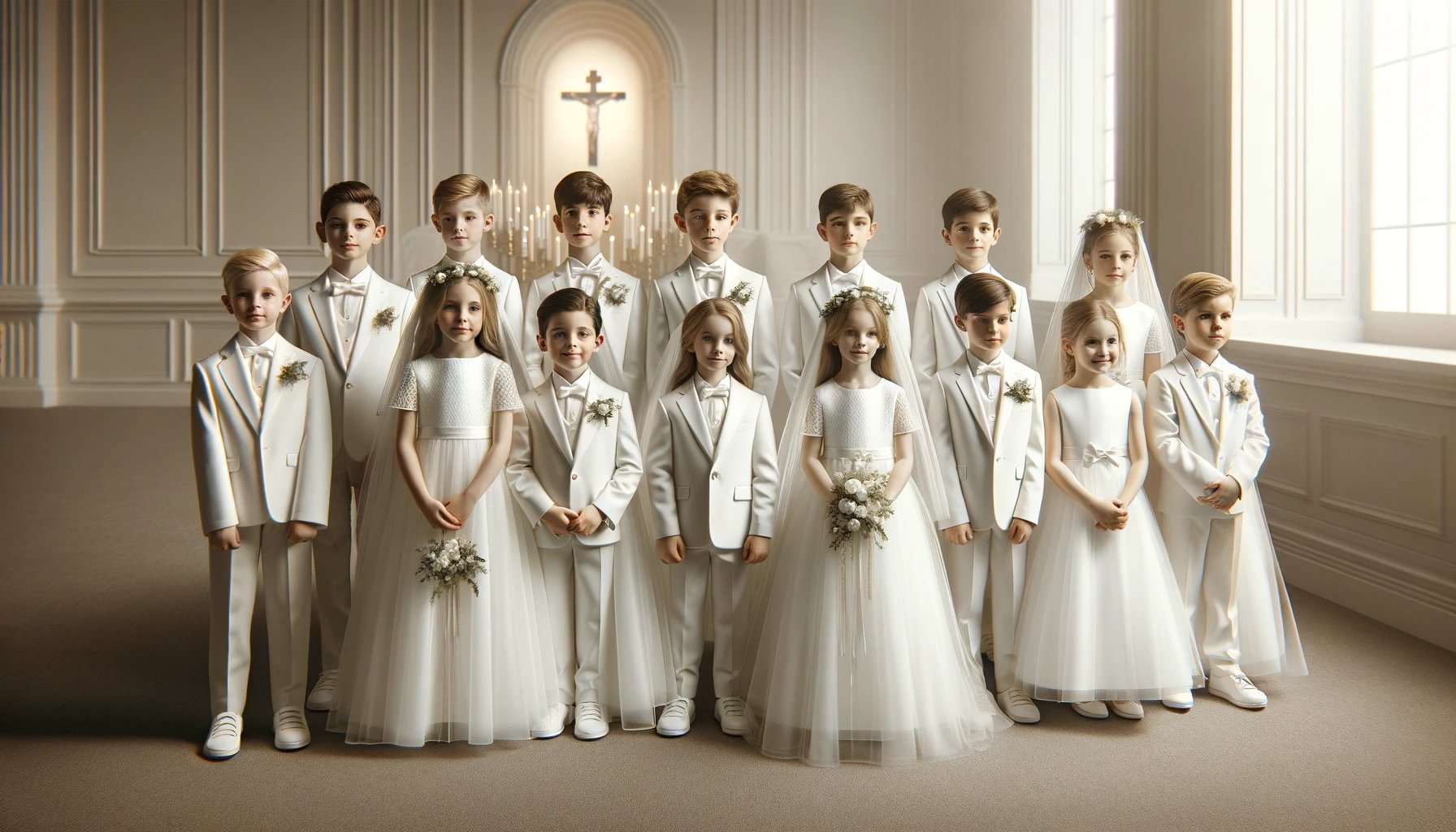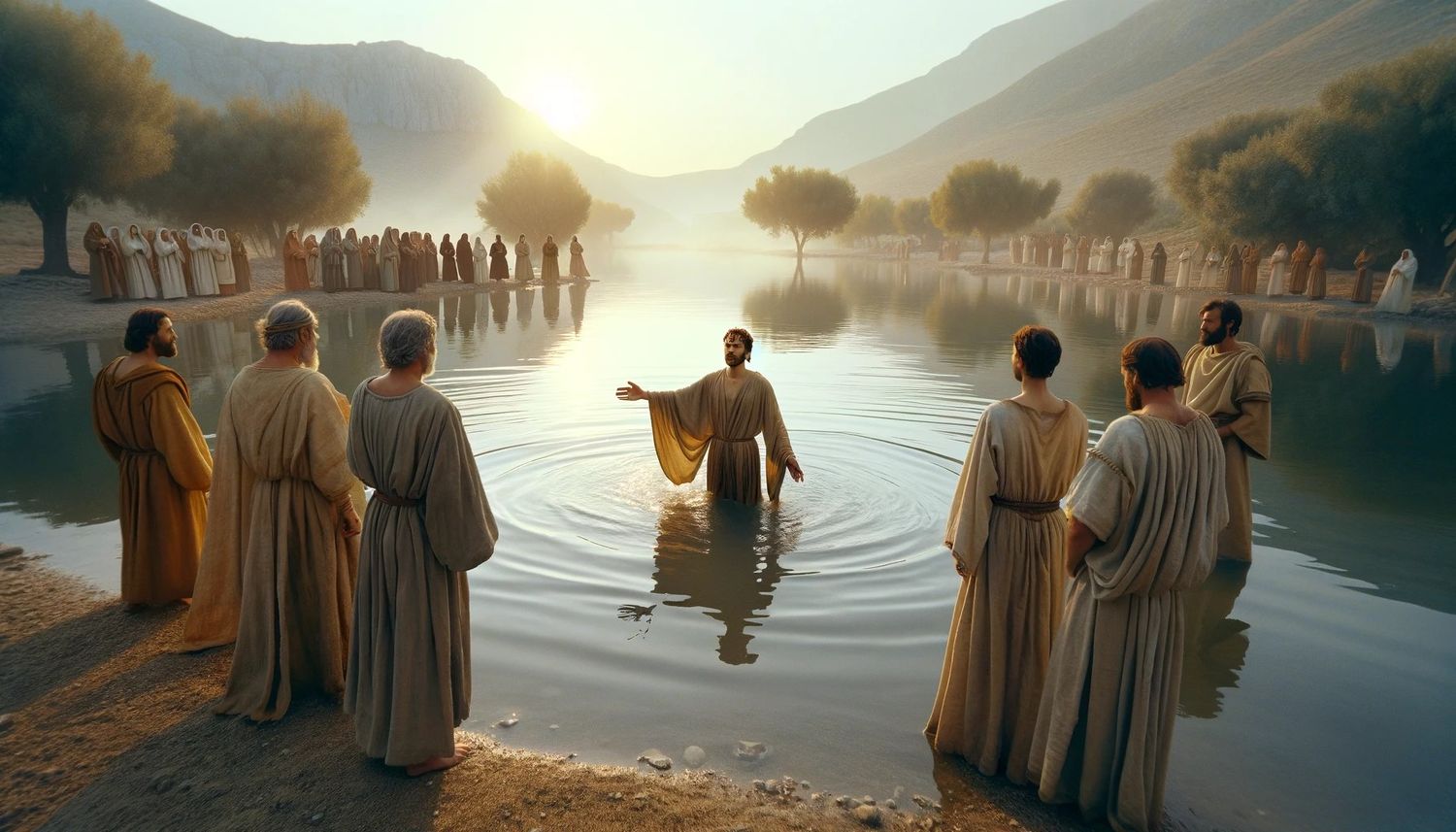Home>Theology and Spirituality>Why Wear White For Baptism


Theology and Spirituality
Why Wear White For Baptism
Published: February 28, 2024
Ericka Andersen, an editor at Christian.net, expertly merges digital strategy with content creation, focusing on faith and societal issues. Her communication skills enhance the platform's engaging narratives, fostering meaningful dialogue on belief's impact on society.
Discover the significance of wearing white for baptism and its symbolism in theology and spirituality. Learn about the spiritual meaning behind this tradition.
(Many of the links in this article redirect to a specific reviewed product. Your purchase of these products through affiliate links helps to generate commission for Christian.net, at no extra cost. Learn more)
Table of Contents
The Symbolism of White in Baptism
White holds significant symbolism in the context of baptism, representing purity, innocence, and the washing away of sins. When individuals are baptized, the act symbolizes their spiritual cleansing and rebirth, marking the beginning of their journey in faith. The color white is often associated with light, goodness, and the divine, signifying the new life and spiritual enlightenment that comes with embracing the Christian faith. In essence, the white garments worn during baptism serve as a visual representation of the individual's commitment to leading a life of virtue and righteousness.
The use of white in baptism also reflects the biblical references to purity and forgiveness. In the Book of Isaiah, it is written, "Though your sins are like scarlet, they shall be as white as snow; though they are red as crimson, they shall be like wool." This verse emphasizes the transformative power of baptism, where one's sins are metaphorically washed away, leaving behind a state of spiritual purity and renewal. The color white, therefore, serves as a powerful symbol of the forgiveness and grace bestowed upon the newly baptized individual by God.
Furthermore, white is often associated with the concept of spiritual illumination and the presence of the Holy Spirit. In the Christian tradition, the white garments worn during baptism symbolize the indwelling of the Holy Spirit within the individual, guiding and illuminating their path as they embark on their journey of faith. This symbolism underscores the idea of spiritual enlightenment and the newfound understanding that comes with embracing the teachings of Christianity.
In summary, the symbolism of white in baptism encompasses themes of purity, forgiveness, spiritual rebirth, and the presence of the Holy Spirit. The use of white garments during this sacred rite serves as a powerful visual representation of the individual's commitment to living a life guided by the principles of faith and righteousness.
Read more: What To Wear Catholic Baptism
Historical Significance of White Garments in Baptism
-
Early Christian Practices: The historical significance of white garments in baptism can be traced back to the early Christian practices of the Church. In the early centuries of Christianity, those who were baptized were often fully immersed in water as a symbol of their spiritual cleansing. Following their baptism, they would be clothed in white garments, signifying their new life in Christ and their status as purified members of the Christian community.
-
Biblical References: The use of white garments in baptism also finds its roots in biblical references. In the Book of Revelation, it is written, "They have washed their robes and made them white in the blood of the Lamb." This imagery of white robes being cleansed in the blood of the Lamb, a reference to Jesus Christ, underscores the idea of spiritual purification and the transformative nature of baptism.
-
Symbolism of Purity and Rebirth: Throughout history, the color white has been universally associated with purity and innocence. In the context of baptism, the act of wearing white garments symbolizes the individual's purity of heart and their rebirth into a new life of faith. This historical significance highlights the enduring symbolism of white as a representation of spiritual cleansing and the restoration of one's relationship with God.
-
Early Christian Art and Iconography: The historical significance of white garments in baptism is also evident in early Christian art and iconography. Depictions of baptism in ancient Christian artwork often feature individuals adorned in white robes, emphasizing the visual symbolism of purity and spiritual renewal associated with the sacrament of baptism. These artistic representations serve as a testament to the enduring historical tradition of wearing white garments during this sacred rite.
-
Cultural Influences: Beyond the early Christian context, the historical significance of white garments in baptism has also been influenced by cultural practices and traditions. In various cultures, the color white has long been associated with rites of passage, purity rituals, and ceremonial occasions, further reinforcing its significance in the context of baptism.
In summary, the historical significance of white garments in baptism is deeply rooted in early Christian practices, biblical references, symbolism of purity and rebirth, early Christian art, and cultural influences. These historical foundations have contributed to the enduring tradition of wearing white attire during the sacrament of baptism, symbolizing the spiritual cleansing and new life experienced by the baptized individual.
Cultural and Religious Traditions of Wearing White for Baptism
-
Christian Symbolism: In Christian traditions, the practice of wearing white for baptism is deeply rooted in the symbolism of purity and spiritual rebirth. The color white represents the cleansing of sins and the emergence of a new life in Christ. This tradition underscores the transformative nature of baptism and the individual's commitment to living a life of faith and righteousness.
-
Cultural Significance: Beyond its religious symbolism, the tradition of wearing white for baptism also carries cultural significance in many societies. In some cultures, white is associated with celebrations, purity, and new beginnings, making it an ideal choice for attire during significant life events such as baptism. The cultural resonance of white further enhances its role as a symbol of spiritual purity and the commencement of a journey in faith.
-
Universal Symbol of Purity: White has been universally recognized as a symbol of purity across various cultures and religions. The use of white garments for baptism transcends specific religious denominations, resonating with the broader human understanding of purity and innocence. This universal symbolism reinforces the profound significance of white attire in the context of baptism as a visual representation of the individual's spiritual purification and renewal.
-
Historical and Traditional Practices: The tradition of wearing white for baptism has been upheld through generations, reflecting the enduring influence of historical and traditional practices. In many Christian communities, the act of adorning white garments during baptism is a time-honored custom that connects individuals to the rich heritage of their faith. This continuity of tradition serves to reinforce the spiritual and communal significance of wearing white for this sacred rite.
-
Cross-Cultural Adaptations: While the tradition of wearing white for baptism has deep roots in Christian and Western cultures, it has also been embraced and adapted by diverse cultural and religious communities around the world. As a result, variations of white baptism attire may incorporate elements of traditional dress specific to a particular culture, demonstrating the flexibility of this tradition in accommodating diverse cultural expressions while maintaining its core symbolism of purity and spiritual renewal.
In summary, the cultural and religious traditions of wearing white for baptism encompass the profound Christian symbolism of purity and rebirth, the cultural resonance of white as a symbol of new beginnings, its universal significance as a symbol of purity, the historical and traditional practices that have sustained this tradition, and its adaptability across diverse cultural and religious contexts. The tradition of wearing white for baptism serves as a unifying symbol of spiritual purification and the commencement of a life guided by faith, transcending cultural and religious boundaries.
Practical Considerations for Choosing White Baptism Attire
-
Comfort and Mobility: When selecting white baptism attire, it is essential to prioritize comfort and mobility, especially for infants and young children. Soft, breathable fabrics such as cotton or linen are ideal choices, ensuring that the individual can move freely and comfortably during the baptismal ceremony.
-
Weather and Climate: Consider the prevailing weather conditions and climate when choosing white baptism attire. For ceremonies held in warmer climates, lightweight and airy fabrics are recommended to prevent discomfort or overheating. Conversely, in cooler climates, selecting slightly heavier fabrics or incorporating layers can provide warmth without compromising the symbolic significance of white attire.
-
Ceremonial Requirements: Some religious traditions or denominations may have specific guidelines or requirements regarding the style and design of baptism attire. It is important to consult with the officiating clergy or religious authorities to ensure that the chosen white garments align with any prescribed ceremonial standards.
-
Cultural and Family Traditions: Families may have cultural or familial traditions associated with baptism attire, influencing the choice of white garments. Incorporating elements of cultural heritage or adhering to family customs can add a meaningful and personal dimension to the selection of baptism attire, enriching the overall ceremonial experience.
-
Practicality and Reusability: Opt for white baptism attire that is practical and reusable, allowing for future commemorative purposes or family traditions. Choosing durable fabrics and timeless designs can ensure that the baptism attire retains its significance over time, potentially becoming a cherished keepsake for the individual and their family.
-
Inclusivity and Accessibility: Consider the inclusivity and accessibility of white baptism attire, particularly in diverse or multicultural settings. Ensuring that the chosen garments are readily available and culturally sensitive can promote a sense of unity and inclusiveness within the community, reflecting the universal nature of the baptismal sacrament.
-
Personalization and Symbolism: While adhering to the tradition of white attire, individuals and families may explore opportunities for personalization and symbolic embellishments. This could include incorporating meaningful motifs, embroideries, or accessories that hold personal or religious significance, further enriching the symbolism of the baptismal garments.
-
Simplicity and Elegance: Embrace the timeless elegance of simple and understated white baptism attire. Avoiding excessive embellishments or elaborate designs can accentuate the purity and symbolism of the white garments, allowing the focus to remain on the spiritual significance of the baptismal ceremony.
In summary, practical considerations for choosing white baptism attire encompass aspects of comfort, climate suitability, ceremonial requirements, cultural traditions, practicality, inclusivity, personalization, and the timeless elegance of the garments. By carefully considering these practical factors, individuals and families can select white baptism attire that not only honors the sacred tradition of baptism but also aligns with their specific needs and cultural contexts.
Modern Trends and Variations in White Baptism Attire
-
Contemporary Designs: In modern times, there has been a surge in contemporary designs for white baptism attire, catering to diverse preferences and style sensibilities. These designs may incorporate modern cuts, subtle embellishments, and updated silhouettes while retaining the traditional symbolism of white garments in baptism. The fusion of contemporary aesthetics with the timeless significance of white attire reflects the evolving nature of baptismal traditions in today's cultural landscape.
-
Gender-Neutral Options: With a growing emphasis on inclusivity and gender neutrality, modern trends in white baptism attire encompass gender-neutral options that eschew traditional gender-specific styles. This shift towards inclusivity ensures that baptism attire is accessible and accommodating to individuals of all gender identities, aligning with the principles of equality and acceptance within contemporary society.
-
Sustainable and Ethical Practices: In response to global movements towards sustainability and ethical consumption, modern variations of white baptism attire may prioritize eco-friendly materials, ethical production methods, and sustainable practices. Families and individuals seeking baptism attire may opt for garments that align with their values of environmental stewardship and ethical sourcing, reflecting a conscientious approach to the selection of white attire for this sacred occasion.
-
Cultural Fusion and Diversity: In multicultural and diverse communities, modern trends in white baptism attire may reflect a fusion of cultural influences and diverse traditions. This may manifest in the incorporation of cultural motifs, patterns, or design elements from various heritage backgrounds, celebrating the richness of cultural diversity while upholding the symbolic significance of white attire in the context of baptism.
-
Personalized Embellishments and Accessories: Modern variations of white baptism attire often embrace personalized embellishments and accessories that hold special meaning for the individual or family. This may include embroidered symbols, monograms, or heirloom accessories that add a personal touch to the white garments, creating a sense of individuality and significance within the ceremonial context.
-
Adaptation to Changing Lifestyles: As lifestyles and family dynamics evolve, modern trends in white baptism attire may adapt to accommodate practical considerations such as ease of care, versatility, and suitability for contemporary lifestyles. This may involve the selection of low-maintenance fabrics, convertible designs, or multi-purpose garments that align with the dynamic needs of modern families while upholding the tradition of white attire for baptism.
-
Digital Accessibility and Customization: With the advent of digital platforms and online resources, modern trends in white baptism attire may encompass digital accessibility and customization options. Families and individuals can explore virtual platforms for personalized consultations, custom fittings, and tailored garment selections, enhancing the accessibility and convenience of choosing white baptism attire in the digital age.
-
Interfaith and Inter-Cultural Influences: In an increasingly interconnected world, modern variations of white baptism attire may reflect interfaith and inter-cultural influences, accommodating diverse religious and cultural backgrounds. This inclusive approach may result in the integration of elements from multiple faith traditions or cultural practices, fostering a spirit of unity and understanding within contemporary baptismal ceremonies.
In essence, modern trends and variations in white baptism attire reflect the dynamic interplay between tradition and contemporary influences, embracing inclusivity, sustainability, personalization, and cultural diversity while upholding the enduring symbolism of white garments in the sacred rite of baptism.















